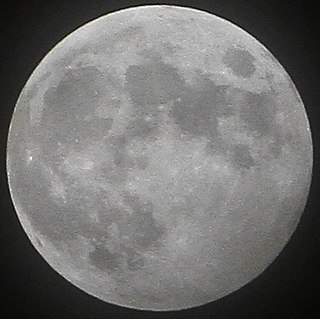
A total lunar eclipse took place on 10 December 2011. It was the second of two total lunar eclipses in 2011, the first having occurred on June 15. A lunar eclipse occurs when the Moon is positioned just right in its orbit to pass through Earth's shadow.

A penumbral lunar eclipse took place on 7 July 2009, the second of four lunar eclipses in 2009. This eclipse entered only the southernmost tip of the penumbral shadow and thus was predicted to be very difficult to observe visually. This lunar eclipse was the predecessor of the solar eclipse of 22 July 2009.

A penumbral lunar eclipse took place on 6 August 2009, the third of four lunar eclipses in 2009. The Moon's small entry into the Earth's penumbral shadow produced an extremely subtle dimming of the Moon's southern edge, difficult to observe visually.

A partial lunar eclipse was visible on 31 December 2009. It was the last and largest of four minor lunar eclipses in 2009. This lunar eclipse was also notable, because it occurred during a blue moon and was near perigee. The next eclipse on New Year's Eve and blue moon will occur on 31 December 2028.

A total lunar eclipse took place at 0308 UT (GMT) on Thursday, August 17, 1989, the second of two total lunar eclipses in 1989.

A partial lunar eclipse took place on 4 June 2012. It was the first of two lunar eclipses occurring in 2012, the second eclipse set to happen on 28 November. The Moon was about 37% covered by the Earth's northern umbral shadow at maximum eclipse.

A penumbral lunar eclipse took place on 24–25 May 2013, the second of three lunar eclipses in 2013. It was visually imperceptible due to the small entry into the penumbral shadow.

A partial lunar eclipse took place on 25 April 2013, the first of three lunar eclipses in 2013. Only a tiny sliver (1.48%) of the Moon was covered by the Earth's umbral shadow at maximum eclipse, but the entire northern half of the Moon was darkened from being inside the penumbral shadow. This was one of the shortest partial eclipses of the Moon for the 21st century, lasting 27 minutes. This was the last of 58 umbral lunar eclipses of Lunar Saros 112.

A penumbral lunar eclipse took place on 18–19 October 2013, the last of three lunar eclipses in 2013.

A total lunar eclipse took place between 27 and 28 September 2015. It was seen on Sunday evening, 27 September, in the Americas; while in Europe, Africa, and the Middle East, it was seen in the early hours of Monday morning, 28 September. It was the latter of two total lunar eclipses in 2015, and the final in a tetrad. Other eclipses in the tetrad are those of 15 April 2014, 8 October 2014, and 4 April 2015.
A penumbral lunar eclipse took place on 23 March 2016, the first of three lunar eclipses in 2016. The Moon was just 2.1 days before apogee, making it very small, so this was a "Micromoon" penumbral lunar eclipse.

A penumbral lunar eclipse took place on 16 September 2016, the last of three lunar eclipses in 2016.

A penumbral lunar eclipse took place on Thursday, June 27, 1991, the second of four lunar eclipses in 1991. The moon entered the Earth's penumbra for about 3 hours, and was difficult to see. This lunar eclipse is the predecessor of the Solar eclipse of July 11, 1991.
A penumbral lunar eclipse took place on Tuesday, May 15, 1984, the first of three lunar eclipses in 1984. This was a deep penumbral eclipse, with the southern limb of the Moon close to the Earth's shadow.

A partial lunar eclipse occurred on 19 November 2021. The eclipse occurred towards a micromoon. This was the longest partial lunar eclipse since 18 February 1440, and the longest until 8 February, 2669; however, many eclipses, including the November 2022 lunar eclipse, have a longer period of umbral contact at next to 3 hours 40 minutes. It was often referred to as a "Beaver Blood Moon" although not technically fulfilling the criteria for a true blood moon (totality).

A total lunar eclipse took place on Wednesday, October 18, 1967, the second of two total lunar eclipses in 1967, the first being on April 24, 1967.
A total lunar eclipse took place on Monday, September 15, 1913. The moon passed through the center of the Earth's shadow.

A total lunar eclipse will take place on September 19, 2043.

A total lunar eclipse will take place on March 13, 2044.

A penumbral lunar eclipse will take place on May 17, 2049.


















































